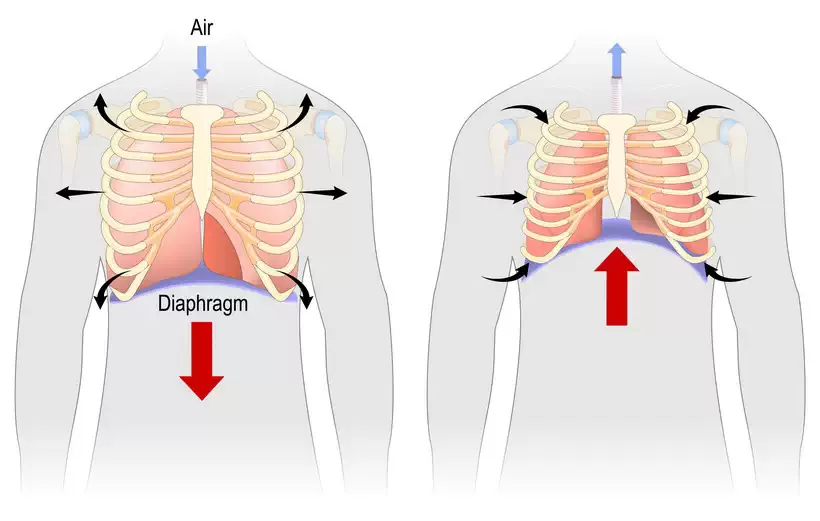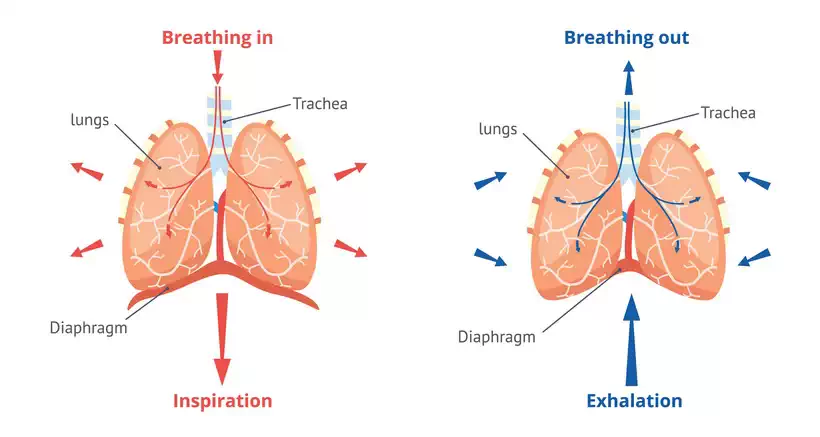If you sing, you already know that your diaphragm plays a major role in the sound of your voice. But in order to really use your diaphragm while practicing vocals, you’ll need to understand how to sing from your diaphragm.
If you aren’t sure what that means exactly, you aren’t alone. We’ll take you through some steps to learn to sing from your diaphragm in this list. We’ll also offer some singing tips to help you revamp your daily routine.
How to Sing From Your Diaphragm
1. What’s Your Diaphragm?

The diaphragm muscle is a sheet of skeletal muscle that separates the abdomen from the chest cavity. It’s located right beneath the lungs and the rib cage.
But it does more than just separate the abdominal muscles from the rest of the torso: the diaphragm works to facilitate breathing, both when you sing and in day-to-day life. When you breathe in, your diaphragm contracts. As it does that, it creates a vacuum that causes air to rush into your lungs. If you’ve ever heard someone reference a “flat diaphragm,” this is what they’re referring to, as the diaphragm flattens as it contracts.
The diaphragm relaxes when you exhale (in general or as you sing). In its relaxed state, it is dome-shaped, with the top of the dome reaching up toward the lungs. That dome shape pushes on your lungs when you exhale and helps to move the air out. The diaphragm holds a lot of power when it comes to singing well, so if you’ve ever taken voice lessons, you’ve likely heard of it.
If you want to become more aware of your diaphragm, slowly inhale and pay attention to your expanding abdomen; this is caused by the flattening diaphragm. Slowly exhale and pay attention to how your abdomen flattens out. If you want to learn more about the diaphragm and see a cool visual as well, check out this short video.
2. Why is Your Diaphragm Important to Your Singing?

Now you know what the diaphragm muscle does. But what’s its connection to vocal performance? If you’re familiar with the term “breath support,” you might already know that the diaphragm is largely responsible for this.
When you sing with proper breath support, you don’t completely relax your diaphragm on the exhale. Since the muscle is still engaged, there’s some “support” for the air in your lungs. Breath support like this is essentially regulating the use of the air supply in your lungs. With your diaphragm engaged, you can sing over a period of time as opposed to just exhaling instantly.
But in order to maintain breath support and sing properly, you need two other things. Breath support involves the breathing mentioned above, the resistance of your vocal cords to airflow through the vocal tract, and resonance (formed from vowel formation when singing).
As a side note, if you learned to sing at a young age, you may have learned to do this without any training. But don’t worry if you haven’t! We’ll take you through the singing steps needed to sing from your diaphragm. If you want to learn more about the physiology of singing, check out this cool video about how the vocal folds, larynx, and diaphragm all work together.
3. Learn to Breathe Into Your Diaphragm

You might have realized that you can’t literally sing from your diaphragm; rather, “singing from your diaphragm” means being able to use your diaphragm for support as you sing. And in order to really be able to do this, it’s important to learn diaphragmatic breathing.
Diaphragmatic breathing also called “abdominal breathing,” is easier than it sounds. It’s the first (and perhaps most important) of the strengthening steps you need to take in order to sing from your diaphragm. Once you’ve mastered this style of breathing, you can move on to some of the singing exercises outlined below. Here’s a quick way to practice breathing from your diaphragm:
- Lie flat or found a place to sit down.
- Keep your shoulders relaxed and push them downward (away from your ears).
- Place one hand on your stomach and the other on your chest.
- Take a deep breath through your nose. Don’tstop breathing in until you can’t take in any more air (don’t strain, though!).
- Make sure that you can feel your stomach expand and that your chest stays fairly still.
- Purse your lips slightly and exhale through them for about 4 seconds. Pay attention to the sensation of your stomach going back down.
- Repeat this several times until you get the hang of it.
When you breathe into your diaphragm, make an effort to not reach your entire lung capacity. That may sound counterintuitive, but there’s a good reason for it. When you breathe in, the bottom part of your lungs will fill first. The lower part of your lungs is surprisingly large, so you should have plenty of air if you inhale deeply but not excessively.
If you take very deep breaths and fill your lungs completely, the air at the top of your lungs will lift up your rib cage. That lift will also create some tension in your larynx, and that tension can have a negative impact on the quality of your voice. If you want some tips for singing without vocal tension, check out this useful video!
4. How To Know if You’re Singing From Your Diaphragm?
Diaphragm incorporation is crucial to singing well. But how do you know if you’re using this proper singing technique?
Do your abdominal and intercostal muscles feel engaged? Your diaphragm works with these muscles to help you regulate your breathing. You should feel some engagement with these muscles, but they should not be overly tense.
Is your throat free from hoarseness or pain? If you have throat discomfort with singing, it is often due to a lack of breath support.
Can you see your stomach contract and expand as you breathe? This is what you want to see. When you breathe properly for singing, the movement in your chest should be minimal.
Of course, if you really, really aren’t sure if you’re singing from your diaphragm, you can consult with a vocal coach. Learning to breathe properly and sing this way isn’t necessarily hard, but if it doesn’t come naturally to you, there may be a bit of a learning curve. Once you get the hang of singing this way, you can practice some targeted singing exercises to strengthen your diaphragm. Check out this useful video if you want one vocal coach’s advice on singing from your diaphragm.
5. Practice Breathing Exercises

In each vocal practice session, it’s not a great idea to just start singing full pieces. After all, warming up your vocal cords will help you sound your best and reduce your risk of any vocal injury.
But it’s also a good idea to include some breathing exercises and/or vocal exercises in your routine before you move into more specific work.
Here are some of the easiest exercises to help you use your diaphragm efficiently to maintain a consistent flow of air and master breath support:
Lip trill. This is a good simple exercise to help you maintain air pressure & effectively use the air supply in your lungs. You keep your lips together but push air out in a controlled manner, resulting in a trilling sound. You can even “sing” a melody while you do so. Combining this exercise with other breathing exercises or diaphragm exercises is a good idea. This video will take you through lip trills!
Balloon exercise. This one is pretty easy, but it will help you really conceptualize breathing from your diaphragm. Imagine your belly contains a balloon. The balloon fills with air when you breathe in. When you exhale, think about slowly releasing the air from the balloon.
Mirror exercise. This breathing exercise is a great way to double-check that you’re breathing from your diaphragm. All you need to do is stand in front of a mirror with your arms outstretched so your body forms a T. Then, breathe deeply while making sure your chest and shoulders stay very still.
6. Make Sure You’re Singing Correctly
If you’re trying to improve your singing voice, make sure you don’t overlook the importance of correct posture when you sing! One of the most important elements here is “alignment” — you want to align your feet to your knees, your knees to your hips, your hips to your shoulders, and your shoulders to your ears.
That means you want to stand with your feet shoulder-width apart. Stand up relatively straight and with generally good posture, but be sure that you aren’t overly tense. Keep your shoulders relaxed, and avoid the urge to suck in your abdomen!
After all, when you breathe, you want to allow your abdomen to expand as needed. Excessive tension anywhere (but especially in your vocal tract) can also cause undesirable vocal tension and negatively impact the sound of your voice. For a more detailed demonstration of proper singing posture, check out this helpful video.
7. Open Your Throat and Work on Articulation

If you want to keep your vocal cords healthy and sound your best, make sure you sing with an open throat. Mastering diaphragmatic singing is a major accomplishment, but if your throat is too tense or closed, you likely won’t get the sound you’re looking for.
To sing with an open throat, pretend there is a ping-pong ball or similar item lodged in your throat and hold it open. Singing this way can take some time to get used to, but it ensures your vocal folds are working optimally.
Diaphragm work can take the focus off other aspects of singing. So once you get the hang of singing with an open throat, take some time to polish your sound by working on singing with hard consonants. Even if you have great technique, overemphasizing hard consonants can interrupt the flow of a song. This video is a great guide to singing hard consonants.
8. Work on Your Head Voice and Chest Voice
While diaphragmatic breathing can really improve your singing voice, it does take some getting used to. And if you’ve been singing for any length of time, you know that you effectively have two voices when you sing. Your head voice is the one you use to sing high notes closer to the top of your vocal range.
These notes feel like they resonate in your head. Your chest voice is used for lower notes, as you can feel them resonate in your chest. You can work on your head voice and chest voice while practicing diaphragm singing.
Pick a high note and hold it. Then gradually sing lower and lower. You should feel yourself slowly move into your chest voice from your head voice. This exercise will help you master the crucial skill of moving between your head voice and chest voice. If you want some more useful tips, this video offers some pointers on moving between the two.
Keep Developing Your Singing Voice?
Hopefully, you now have a sense of how to sing from your diaphragm. This is just one step toward reaching your full potential as a vocalist! If you want useful singing tips, breathing exercises, etc., an online singing course might be right for you. Vocal training done online can work around your schedule, and most sites let you take full courses, select individual lessons, or both.
You can gain valuable knowledge in areas like hitting high notes, mastering better breathing when you sing, or even just developing a daily routine. Whether you have some experience and want to become a better singer or are just looking to take singing lessons for the first time, an online course can help!
Final Thoughts
Now that you know how to sing from your diaphragm and use diaphragmatic breathing, we hope you feel confident in your ability to sing better. Whether you take singing lessons or are learning on your own, you’re well on your way to improvement.
But what do you think? Do you have any more breathing tips we’ve missed? Was there a moment in your vocal training where you really understood how to breathe from your diaphragm? Let us know in the comments, and please don’t forget to like and share if you found this list useful!
